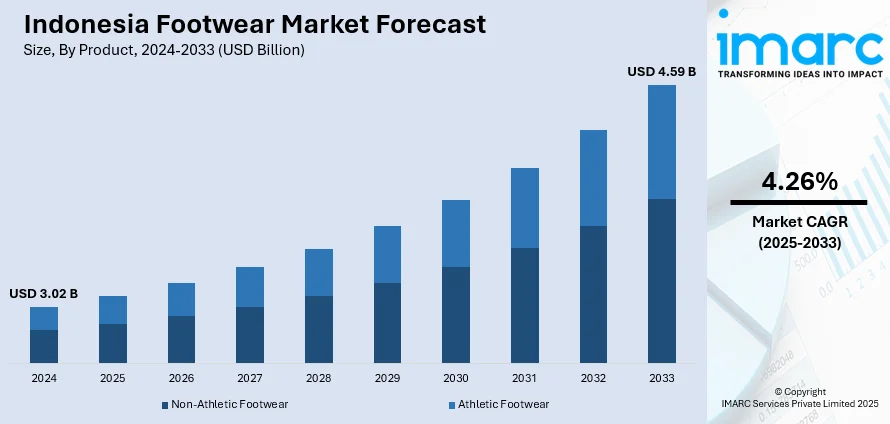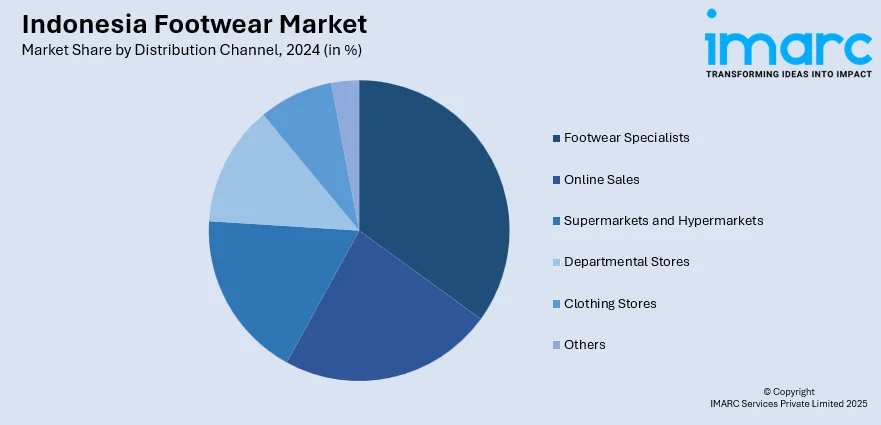
Indonesia Footwear Market Size, Share, Trends and Forecast by Product, Material, Distribution Channel, Pricing, End-User, and Region, 2025-2033
Indonesia Footwear Market Overview:
The Indonesia footwear market size reached USD 3.02 Billion in 2024. The market is projected to reach USD 4.59 Billion by 2033, exhibiting a growth rate (CAGR) of 4.26% during 2025-2033. The market is witnessing consistent expansion, supported by rising consumer spending, a growing fashion-conscious population, and increased demand for both athletic and casual footwear. Local manufacturing strength and evolving retail infrastructure are also playing pivotal roles in boosting market accessibility across urban and rural areas. Furthermore, digital platforms are accelerating product visibility and consumer reach. With these factors combined, analysts anticipate robust performance and long-term potential in the Indonesia footwear market share.
|
Report Attribute
|
Key Statistics
|
|---|---|
|
Base Year
|
2024
|
|
Forecast Years
|
2025-2033
|
|
Historical Years
|
2019-2024
|
| Market Size in 2024 | USD 3.02 Billion |
| Market Forecast in 2033 | USD 4.59 Billion |
| Market Growth Rate 2025-2033 | 4.26% |
Indonesia Footwear Market Trends:
Eco‑Material Innovation Fuels Sustainable Expansion
Indonesia’s footwear sector is advancing its commitment to sustainability by integrating eco-conscious materials and production methods. In August 2024, government-led initiatives promoted green certifications for facilities, encouraging the adoption of water-efficient dyeing techniques, solar energy systems, and zero-waste practices. These efforts directly support Indonesia footwear market growth by aligning with domestic consumer preferences and enhancing export appeal among environmentally conscious buyers. Circular economy strategies—such as take-back programs, lifecycle management, and recycling partnerships are gaining traction, lowering dependency on virgin resources and improving supply-chain resilience. Collaboration among manufacturers, suppliers, and certification agencies is improving value chain transparency and reinforcing sustainability credentials. As ethical consumption becomes more prevalent, eco-innovation is becoming a defining feature of Indonesia’s footwear industry, offering competitive advantage and long-term brand loyalty in a global market increasingly focused on sustainable production.

To get more information of this market, Request Sample
Cultural Craftsmanship Inspires Design Evolution
Indonesia’s footwear market is celebrating its cultural heritage by blending traditional craftsmanship with contemporary design. Since mid-2024, artisans in regions such as Bali and Java have incorporated hand-weaving, batik patterns, and natural dyes into modern footwear collections. These culturally infused styles are gaining traction in both domestic and international markets, appealing to consumers seeking authenticity and artisanal value. The revival of these methods has strengthened rural artisan communities and preserved indigenous skills, contributing to socioeconomic development in craft regions. Integrating artisanal techniques into commercial products is becoming a noteworthy Indonesia footwear market trend, differentiating brands and supporting product diversification. This cultural fusion enhances export potential and consumer interest, as heritage-infused footwear resonates particularly well in niche segments and boutique retail outlets. As global appetite for authentic, story-rich products grows, Indonesia’s footwear sector is poised to leverage its cultural craftsmanship to secure increased market relevance and consumer loyalty.
Digital Commerce Revolutionizes Footwear Distribution
Indonesia's footwear sector is experiencing a swift digital shift, rewriting the way products are delivered to consumers nationwide. During 2024, online marketplaces have been essential channels for shoe sales, mainly among digitally inclined younger consumers. Top online marketplaces are incorporating AI-powered features like virtual showrooms and personalized product suggestions, which drive shopper interaction and minimize returns. In June 2024, a primary digital retail study indicated that close to 40% of shoe purchases took place online, indicating a remarkable shift from the usual brick-and-mortar stores. To complement this expansion, logistics solutions have come a long way with next-day delivery facilities, mobile-enabled checkout systems, and easy return policies that enhance customer trust. The digital transformation also empowered small brands and craftsman communities to grow rapidly by reaching consumers across the country without huge capital investments. Better supply chain visibility tools aid in managing inventory between online and offline channels, eliminating overstocking and enhancing order accuracy. With growing internet penetration in Indonesia, footwear retail digitization is establishing new standards in distribution, enabling brands to act promptly in reacting to demand signals and consumer trends. This change is setting Indonesia's footwear industry up for future robustness and scalable expansion.
Indonesia Footwear Market Segmentation:
IMARC Group provides an analysis of the key trends in each segment of the market, along with forecasts at the country and regional levels for 2025-2033. Our report has categorized the market based on product, material, distribution channel, pricing, and end-user.
Product Insights:
- Non-Athletic Footwear
- Athletic Footwear
The report has provided a detailed breakup and analysis of the market based on the product. This includes non-athletic footwear and athletic footwear.
Material Insights:
- Rubber
- Leather
- Plastic
- Fabric
- Others
A detailed breakup and analysis of the market based on the material have also been provided in the report. This includes rubber, leather, plastic, fabric, and others.
Distribution Channel Insights:

- Footwear Specialists
- Online Sales
- Supermarkets and Hypermarkets
- Departmental Stores
- Clothing Stores
- Others
The report has provided a detailed breakup and analysis of the market based on the distribution channel. This includes footwear specialists, online sales, supermarkets and hypermarkets, departmental stores, clothing stores, and others.
Pricing Insights:
- Premium
- Mass
A detailed breakup and analysis of the market based on the pricing have also been provided in the report. This includes premium and mass.
End-User Insights:
- Men
- Women
- Kids
The report has provided a detailed breakup and analysis of the market based on the end-user. This includes men, women, and kids.
Regional Insights:
- Java
- Sumatra
- Kalimantan
- Sulawesi
- Others
The report has also provided a comprehensive analysis of all the major regional markets, which include Java, Sumatra, Kalimantan, Sulawesi, and others.
Competitive Landscape:
The market research report has also provided a comprehensive analysis of the competitive landscape. Competitive analysis such as market structure, key player positioning, top winning strategies, competitive dashboard, and company evaluation quadrant has been covered in the report. Also, detailed profiles of all major companies have been provided.
Indonesia Footwear Market News:
- March 2025: Indonesia’s Ministry of Industry announced a collaborative initiative to train Sri Lankan workers in leather and footwear processing, showcasing Indonesia’s leadership in footwear expertise. The training program, set for August 2025 at ATK Yogyakarta Polytechnic, aims to strengthen bilateral ties and enhance skill development in the footwear sector. This initiative highlights Indonesia’s commitment to regional cooperation and knowledge sharing, reinforcing its position as a key player in the global footwear industry. The positive impact is expected to benefit both countries’ industries and economies.
Indonesia Footwear Market Report Coverage:
| Report Features | Details |
|---|---|
| Base Year of the Analysis | 2024 |
| Historical Period | 2019-2024 |
| Forecast Period | 2025-2033 |
| Units | Billion USD |
| Scope of the Report |
Exploration of Historical Trends and Market Outlook, Industry Catalysts and Challenges, Segment-Wise Historical and Future Market Assessment:
|
| Products Covered | Non-Athletic Footwear, Athletic Footwear |
| Materials Covered | Rubber, Leather, Plastic, Fabric, Others |
| Distribution Channels Covered | Footwear Specialists, Online Sales, Supermarkets and Hypermarkets, Departmental Stores, Clothing Stores, Others |
| Pricings Covered | Premium, Mass |
| End-Users Covered | Men, Women, Kids |
| Regions Covered | Java, Sumatra, Kalimantan, Sulawesi, Others |
| Customization Scope | 10% Free Customization |
| Post-Sale Analyst Support | 10-12 Weeks |
| Delivery Format | PDF and Excel through Email (We can also provide the editable version of the report in PPT/Word format on special request) |
Key Questions Answered in This Report:
- How has the Indonesia footwear market performed so far and how will it perform in the coming years?
- What is the breakup of the Indonesia footwear market on the basis of product?
- What is the breakup of the Indonesia footwear market on the basis of material?
- What is the breakup of the Indonesia footwear market on the basis of distribution channel?
- What is the breakup of the Indonesia footwear market on the basis of pricing?
- What is the breakup of the Indonesia footwear market on the basis of end-user?
- What is the breakup of the Indonesia footwear market on the basis of region?
- What are the various stages in the value chain of the Indonesia footwear market?
- What are the key driving factors and challenges in the Indonesia footwear?
- What is the structure of the Indonesia footwear market and who are the key players?
- What is the degree of competition in the Indonesia footwear market?
Key Benefits for Stakeholders:
- IMARC’s industry report offers a comprehensive quantitative analysis of various market segments, historical and current market trends, market forecasts, and dynamics of the Indonesia footwear market from 2019-2033.
- The research report provides the latest information on the market drivers, challenges, and opportunities in the Indonesia footwear market.
- Porter's five forces analysis assist stakeholders in assessing the impact of new entrants, competitive rivalry, supplier power, buyer power, and the threat of substitution. It helps stakeholders to analyze the level of competition within the Indonesia footwear industry and its attractiveness.
- Competitive landscape allows stakeholders to understand their competitive environment and provides an insight into the current positions of key players in the market.
Need more help?
- Speak to our experienced analysts for insights on the current market scenarios.
- Include additional segments and countries to customize the report as per your requirement.
- Gain an unparalleled competitive advantage in your domain by understanding how to utilize the report and positively impacting your operations and revenue.
- For further assistance, please connect with our analysts.
 Request Customization
Request Customization
 Speak to an Analyst
Speak to an Analyst
 Request Brochure
Request Brochure
 Inquire Before Buying
Inquire Before Buying




.webp)




.webp)












